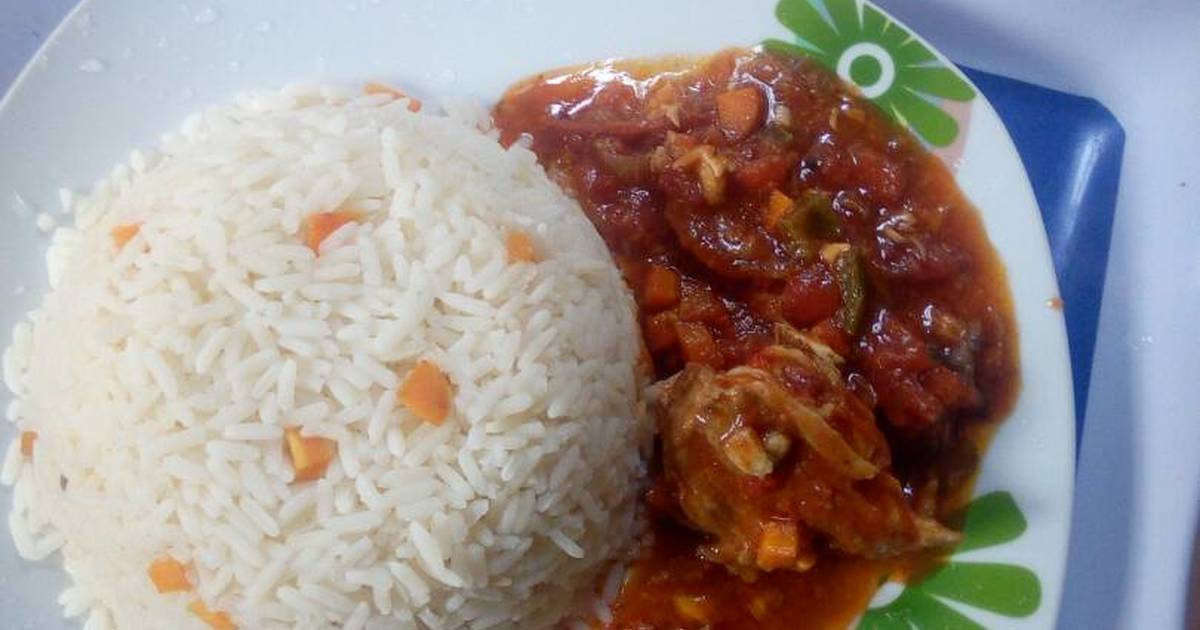What do you know about white rice and stew? Yes, we published an article lately on that food combination, yet there is a still need for another publication because we believe that there are so many things yet to be covered.
White rice and stew compose a classic dish that transcends cultures and continents, offering a comforting and flavorful experience. The simplicity of steamed white rice serves as the perfect canvas for the rich and aromatic stew, creating a harmonious balance of textures and tastes.
Whether it’s a tomato-based stew with tender chunks of meat or a hearty vegetable stew bursting with spices, the combination never fails to satisfy.

Each spoonful of rice soaked in the savory sauce of the stew transports one to a realm of culinary delight, where every bite tells a story of tradition, warmth, and culinary mastery.
White rice and stew epitomize the essence of home-cooked meals, bringing people together around the dinner table to savor moments of shared joy and contentment.
How Can I Cook White Rice and Stew?
Cooking white rice and stew is a simple yet satisfying culinary endeavor. To begin, rinse the rice thoroughly under cold water to remove excess starch, which can cause the rice to become sticky. Then, place the rice in a pot with water at a ratio of 1:2 (one cup of rice to two cups of water).
Bring the water to a boil, then reduce the heat to low, cover the pot, and let the rice simmer for about 15-20 minutes, or until all the water is absorbed and the rice is tender. Fluff the rice with a fork before serving to ensure it is light and fluffy.
While the rice is cooking, prepare the stew by sautéing onions, garlic, and any desired vegetables or meats in a separate pot until they are tender and aromatic.
Add in canned tomatoes, tomato paste, and seasonings such as salt, pepper, and spices like paprika or cumin to create a flavorful base. Let the stew simmer for at least 20-30 minutes to allow the flavors to meld together and the sauce to thicken.
Once both the rice and stew are ready, serve the rice alongside the hearty stew for a comforting and delicious meal that is sure to satisfy any appetite.
Can I Add Rice to Stew?
Yes, you can add rice to stew! Adding rice to stew is a fantastic way to create a heartier, more filling dish. To incorporate rice into your stew, you can simply add uncooked rice directly to the pot along with the other ingredients.
Keep in mind that the rice will absorb some of the liquid from the stew as it cooks, so you may need to adjust the amount of liquid or add more broth or water if necessary to achieve your desired consistency.
Alternatively, if you prefer to cook the rice separately, you can still add it to the stew towards the end of the cooking process. Simply prepare the rice separately, then add it to the stew during the final stages of cooking, allowing it to simmer for a few additional minutes to absorb the flavors of the stew.
This method allows you to control the texture and consistency of both the rice and the stew, ensuring that they complement each other perfectly. Overall, adding rice to stew is a delicious and versatile way to create a comforting and satisfying meal.
What is Healthy to Eat with White Rice?
Consider eating it with fiber-rich foods to make it more filling and to boost your intake of nutrients.
White rice can be served with peas and beans or with lean cuts of meat, fish, and vegetables to create balanced and nutritious dishes.
What Not to Put in a Stew?

When making a hearty stew, it’s essential to consider ingredients that may not fare well under prolonged cooking or could overpower the dish’s delicate flavors.
Avoid incorporating delicate vegetables like leafy greens or high-water-content veggies such as lettuce or cucumbers, as they can turn mushy and lose their texture.
Overuse of overpowering spices or combining too many spices can mask the natural flavors of the ingredients, so it’s best to strike a balance and taste as you go.
Dairy products like milk or cheese can curdle if added directly to a stew, especially if simmered for an extended time, so add them towards the end of the cooking process with caution.
Pre-cooked seafood like shrimp or fish can become tough if simmered too long, so if you opt to include seafood, add it towards the end and cook it gently until just done. By avoiding these pitfalls, you’ll ensure your stew is flavorful, hearty, and perfectly balanced.
Now, it is certain that you have learned a lot about white rice and stew, and you can easily prepare the delicacy in a good way without the assistance of anyone. However, if you have any questions to ask, kindly drop them in the comment section below.


Leave a Reply